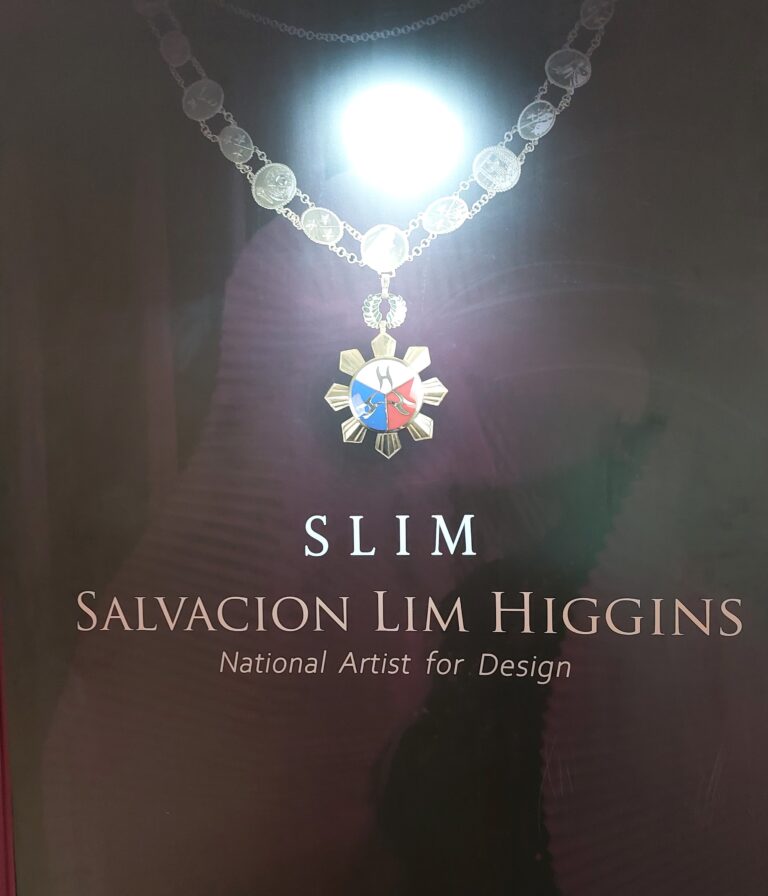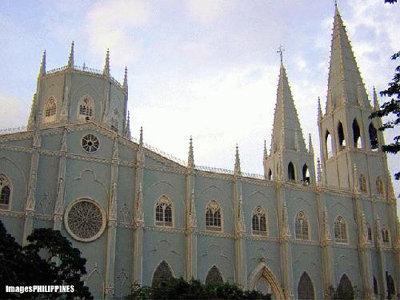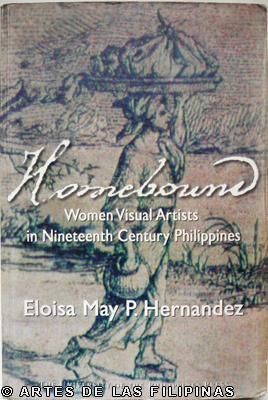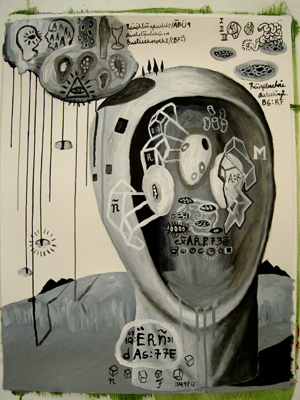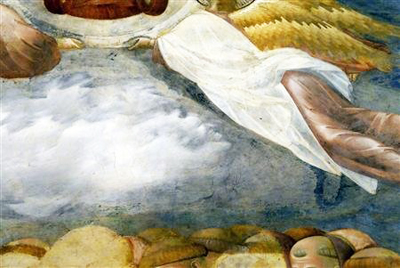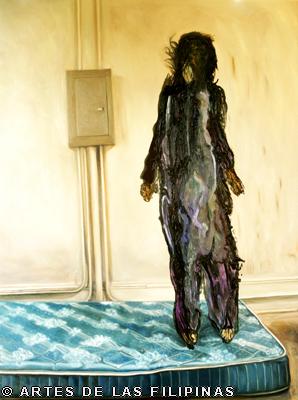
KEIYE MIRANDA’S MOVING WATERS
by: Christiane L. de la Paz
September-October 2010— Keiye Miranda has burst upon the art scene in 1998 roaming freely among photography, gallery assisting, art teaching and painting. But despite her various activities in this period, she immersed herself in modern art and experimented with photography as a starting point for her early works. Her practice and exposure has then led her to produce paintings based on the theme of underwater pool. To her many followers, this series of painting is a celebration of what it is to be alive – perpetual sunshine, relaxed atmosphere, carefree days at the pool and all year summer vacation. But while a few of her critics observe that her images of pool water is completely her own, the gradual changes in her style as well as the stories she has told in these works have received considerable attention among many of her followers. Her principal paintings have entered notable private collections and have since been fast becoming one of the more independent female artists of the contemporary period. Keiye Miranda, in this interview, tells the beginning years of her career, the milieu in which she was formed, her visual intelligence and her artistic integrity in creating her body of work that invites the viewers’ investigation.
What kept you busy after graduating from the University of the Philippines in 1998?
Born out of the desire to discover and create art just like my father, Nemi Miranda, and my enthusiasm and eagerness in exploring things, I decided to become an artist just like my Dad. I was exposed to art at an early age. It was my family’s source of livelihood, our bread and butter. But on hindsight, I know how difficult it is to pursue a career as an artist. As the eldest among five children, I witnessed all of my father’s struggles and this affected me when I started my career.

Untitled (1999)
What was the first job you applied for?
After finishing college, I decided to become a full-time artist. Once in a while, I assisted my Mom in some of the gallery operations in SM Megamall. We also conducted art workshops for the kids and adults there. And then in March 1998, Wire Tuazon had established an artist-run and alternative space called Surrounded by Water here in our hometown in Angono. Despite the lack of institutional and financial support, our group aims to be an alternative platform to cater to the specific needs of the young and emerging artists. With several concerns facing artists at the beginning of their careers, my batchmates and I assisted Wire in these programs, exhibitions and other gallery related works. And since my family had been managing a gallery in SM Megamall- Art Walk, I had knowledge of how a gallery runs. The space existed for almost two years, from 1998 until around the last quarter of 1999. Later, we rented another space in EDSA besides POEA and across Robinson’s Galleria. This new space was offered to Wire for free by a very kind couple with a passion for art. Since the space in EDSA is big for a start-up gallery, we asked our friends if they are willing to help us run the space and if they would be willing to volunteer their time in overseeing its operations. I remember that it was a big responsibility for all of us in doing this — managing to survive — and so we had to schedule day shifting and employed a DIY hybrid practice. The gallery ran for more than a year. And a few days before we close this space, we decided to have a three day sell-out of the works in our stockroom to lessen the works we are to bring home. Surprisingly, it attracted so much attention from collectors and people who were starting to collect.
Then in 2002, another space was offered to Surrounded by Water in 18th Avenue in Cubao. The space ran for a year. All of us have since become busy with our individual careers and some of us were being offered by major galleries to show and exhibit. At that time, I was actively participating in exhibitions with my contemporaries and doing some solo shows. Those years were a learning experience for all of us and we created some new and exciting works. It was in Surrounded by Water where we all started our careers and it opened doors for all of us.

Exhale (1999)
You first entered the art scene in 1997, what is the status of the art scene during those time?
I remembered that to have your works exhibited in an established gallery, you have to have a name and your works must be commercially viable. Finding no sympathetic home in these institutional spaces, contemporary artists have began to create their own alternative exhibition spaces. This is the reason why, in the late 1990s, there was an influx of young artist-run-spaces for them to realize their own projects.

Breathe (1999)
Was Fine Arts your first course?
Yes but I was first a Studio Arts major and then I shifted to Visual Communication after a year. I got confused then whether I’ll be able to make it as an artist or to just maintain a regular job. One of the factors that pushed me to shift is that I asked myself if I can sustain my life as a full-time artist knowing how difficult it is to be given a break. But in college, I realized also that I’m not happy with the pressure of meeting deadlines if I decide to work in advertising firms so I decided to shift to Studio Arts where I can gain fulfillment with what I’m doing. That was in 1998 and up to now I’m still doing what I love most, painting! I guess it’s my calling.

Perimeter of Time (2000)
Who are your contemporaries in UP?
My classmates in Studio Arts were Wire Tuazon, Geraldine Javier, Yasmin Sison, Jonathan and Mariano Ching, Mike Muñoz, Ringo Bunoan, Mike Adrao, Eric Roca, Jayson Oliveria, Lena Cobangbang, Erik Sausa, Kreskin Sugay, Katya Guerrero, Vincent Padilla, Italo Tajo, Jamel Obnamia and Amiel Roldan. Most of my batchmates are very active in the contemporary art scene while some are teaching and working still in the field of art.

Listen (2000)
Who are some of the stars of your batch?
Katya Guerrero because most of us admire her conceptual works. There’s also Geraldine Javier and Yasmin Sison whose works were done well even during their student years. Ghe’s works are intricate and her approach is almost clinical when painting while Yasmin’s works, on the other hand, are painterly and rich in texture. Both of them are my close friends and both are excellent painters in their own rights.

Discover My Dream (2000)
Tell me about your first exhibit.
I had my first solo exhibition at Surrounded by Water and simultaneously I also had a show at the Nemiranda Arthouse in SM Megamall. This was the time when I started doing my underwater series. Both exhibitions were well received and I got a lot of encouragement from family and peers. This inspired me to continue my art.

Matang Tubig (2000)
What did you do with the income you generated from the sales?
A big portion of it went to the bank as my personal savings and a portion was used to buy art materials to use for my next show. I also spent some for my personal things.

Until You Come Back (2000)
Was this your first paycheck or have you sold other works prior to your first exhibit?
I was already selling a few of my paintings before I entered college. I was part of an art group in Angono where we held group exhibitions. Some of my school plates were also sold which was a big boost for me since I was just starting my career then.

One (2001)
What was the first gallery that carried your works?
Surrounded by Water but Finale Art File was the first gallery that invited me to be one of their house artists.
For some artists whose parents are painters, the collectors of their parents have also become the collectors of the works of their sons or daughters. Did this scenario ever happen to you?
I think this is applicable if both artists have the same style then they can both arrive with the same collectors. But in my case, my work and my style is totally different from my father.

Kiss (2001)
How do you try to be different in concepts and executions for your exhibits?
When I started doing the series of underwater paintings, I knew that my approach was new and different. I’ve never seen any work similar to my paintings. I drew ideas from my collection of photographs that I’ve personally taken. Sometimes, I also browse the Internet and art books to be aware of what is current in the international and local art scene. Sometimes when I see the works of my contemporaries, an idea would just pop from my head and this would inspire me on what to do next.

Reading Between the Lines (2001)
When you are in the process of working, who exactly is the viewer you have in mind?
Painters are the first viewers of their works but in my case my family is the viewer and critic of my works.

Echoing From Nowhere (2001)
Do you agree that the first exhibit of a painter could make or break his career? Did this apply to you?
I think first impression on the first solo exhibit of a painter can bring a big impact to the viewers because it serves as a debut in entering the art world. But that doesn’t mean that if one’s first exhibit fails then it becomes the end of his career. But if this ever happens, I think artists should accept it as a challenge and be more aggressive in learning and developing his art.

Lost Memories (2001)
Are you a member of any artist’s group? What do you think are the advantage of being part of an artist’s group?
I am a member of Surrounded by Water and the Neo-Angono Artists Collective. Being part of an artist’s group requires personal commitment and a consciousness of the group’s mission and vision. One must also be responsible for his actions because whatever achievement or failure the group achieves, it will reflect in each member of the organization.

Lift (2003)
Tell me about the Neo-Angono Artists Collective.
The Neo-Angono Artists Collective was established in 2004 after Surrounded by Water bow out. It is a movement and an organization founded by visual artists, writers, poets, musicians, theater people, filmmakers, cultural workers, art enthusiasts, critics and researchers. Majority of the members of Neo-Angono are residents of Angono and the neighboring towns of Rizal, Manila, Mindanao and even Japan. Neo-Angono spearheaded the Annual Public Art Festival for the last seven years and continues to contribute to art research and education.

Periodic Phenomenon (2005)
Have you ever won any important awards?
None so far.
Do you think awards help make a painter become commercially recognized?
Yes, at some point an artist recognizes his potentials and creative aspects by winning an award. This may also help build one’s career if you’re an upcoming artist. Some artists gauge their success by winning an award but awards are just bonus points. At the end of the day, the acquisition value depends on the viewers and collectors.

Boundaries 1 (2006)
Do you think a painter can become commercially successful without receiving any award?
Yes. If an artist is passionate in his chosen craft, he can excel and become successful. But I think it’s not only awards that legitimize the success of an artist: his attitude, dedication towards the projects and the way he works with people also counts.

Great Expectations (2006)
Why did you choose the element of water to become the trademark of your works?
The water element in my work started from my college thesis where I painted the water’s surface of a swimming pool in shaped canvas. I find it exciting that the reflection of light that was created by the water’s erratic movement produces a complex and resonating pattern in my works. Since then, I began to utilize the subject of water to indicate personal space where time, memory, thoughts and experiences can produce an ambiguity of the real and unreal. It also provided for me sets of new terms of encountering reality.

Look Out (2007)
David Hockney uses composite image in producing his works. Tell me about the process you do prior to painting your subjects.
Though I’m not that good in photography, most of my studies are based on my underwater photographs. I use a regular instamatic Canon underwater camera with a film since I started this series. Its dual-purpose features produced convenience and its manual settings suits my needs. Over the years, I realized that I have accumulated so much photographs that they became my source studies or painting references. While utilizing a pool as a location or setting for my works, I usually make a re-visioning of objects or scenes that are easily found in daily life. Through the different setting and shooting conditions dictated by the use of light, depth and instinct, I produced images that unravel in various manners. Sometimes, if my photographs did not come out well, I manipulate the image by using Photoshop to suit my vision.

From A Distant Look (2007)
Do you use a specialized camera for your works?
I recently acquired a Liquid Image diving mask with a built-in digital video camera. So I just dive, swim, shoot and enjoy the whole process.

Journal of Anxiety (2008)
Do you consciously try to achieve a motion blur effect in your works?
While tapping into different views through subtle shifts and careful observations, I think it is natural for my images to look subdued.
Do you personally take the photos of your subject underwater or do you have someone else do this for you?
Yes, most of them are my own works but in few instances, my husband, Wire, served as my photographer and production designer. But overall, I always do my own shooting. In fact, our daughter, Ashiya, is also my part-time model but this only happens when she’s in a good mood. Whenever a show is near, I usually reserve a private pool so I can bring my materials to use for the shoot. It’s art-making and at the same time a family-outing where there is plenty of swimming and chill time.

Attempt For A Dialogue (2008)
Do you have any experience in underwater photography?
I took up photography as an elective class when I was in college. Since then, it has become an integral part of my art-making process and a flexible framework for different formats. Now, I see underwater photography as an engagement in channeling the periphery of my senses.

Relief of Discomfort (2008)
The water in your works is pool water, have you tried capturing your subject under sea?
Yes, I’ve tried it before when we went to the beach but the weather did not cooperate. The sunlight was bad which resulted in bad photos. We went snorkeling instead so it was still fun.

Silent Witness (2008)
Do you swim well?
I took up swimming lessons when I was about ten years old.

Blurred Imagination (2008)
What do your parents and siblings have to say about your works?
Back in college, my father minds and criticizes my works whenever I’m doing my plates. Maybe, he can’t understand my works because they were different from the traditional genre paintings that he has been doing. But now, my family appreciates everything that I do and they support me in whatever endeavors I take.

Underwater Series 9 (2008)
Who handles the business side of your profession?
Finale Art Gallery. They do the marketing, programming of exhibitions, documenting works and providing for the artists’ needs.

Underwater Series 15 (2008)
Why are you amenable to being exclusive to one gallery?
Being represented by a gallery may be beneficial or disadvantageous to some artists. This of course depends on the nature of the agreement you have with them because galleries have different terms and arrangements. In my case, I started exhibiting my works in Finale with my husband, Wire, even when we were still in college. It was Professor Chabet who introduced us to the owners and staff and soon they gave us slots to exhibit our works. Since then, we had solos and two-person exhibits every year. Some of it ended without sales but despite the come out, Finale continues to invite us in their shows. After years of exhibiting with them, they asked us to be part of their roster of house artists. We said yes right away because Finale was among the first gallery that supported us when we were starting out.

Underwater Series 13 (2008)
Do you have an idea of the profile of collectors who buy your works?
I’m not familiar with most of my collectors but some of them are foreigners and young collectors while the others are my friends.

Underwater Series 11 (2008)
What has been the best compliment said about you or your work?
I remember Raymond Lee, a friend, who loves and bought my work. He called and told me that he’s happy with my painting. I thanked him for the compliment and I told him that he might dream about it because of his excitement. I appreciate collector’s support and enthusiasm because as an artist, comments like that give me a sense of fulfillment and satisfaction.

Underwater Series 10 (2008)
During your student days, which local painters had an influence on your art?
Roberto Chabet was a big influence on my art. As a teacher, he was very generous in sharing his knowledge to his students. I found him insightful and critically perceptive. Sir Chabet molded each of us according to our potentials and capabilities.

Looking for a Perfect Match (2009)
How about the style you are drawn to painting during your student days?
Back in college, I already admire the works of David Hockney. But these days, I am very much interested in Elena Kalis’ works.

Into the Realm of Consciousness (2009)
You mentioned Roberto Chabet as being a mentor, who are the other people who have influenced your development as an artist?
My father. He was the one who started teaching and honing my talent as an artist.

Disrupted Happenings 1 (2009)
How were you introduced to art when you were growing up?
The art community in Angono, Rizal then was very much alive. There were art activities for the youth like the anticipated on-the-spot painting contests and the Annual Art Exhibition held in our town plaza. This was organized by the Angono Ateliers Association that was once led by my father who also happens to be one of its pioneers. My siblings and I were encouraged to join these contests. Sometimes, my Dad would also invite us to participate in some of their sketching and drawing sessions. So growing up exposed to this kind of environment is really helpful especially when I was growing up. This experience motivated me to continue making art and hopefully, it will also inspire the succeeding generations of artists in developing their talents in a similar vein.

Disrupted Happenings 3 (2009)
Of course, you have been asked many times about your father, Nemi Miranda, but could you share some insights about being his eldest daughter?
My Dad taught us how to draw and paint at an early age. I guess it was normal for a father to inculcate in his children the nature of his work and the techniques involved in it. However, there’s a bit of expectation to children of artists especially when I was starting out. I remember the first few paintings I did, I tried to imitate some of my Dad’s works but it appeared raw and unrealistic. With that experience, I decided to come up with my own style which is ok with my Dad.

Sunken Playground 6 (2009)
What does your Mom do?
My Mom manages the business side of art ever since. She supervises the marketing while my father do commissioned works and handles the programming of exhibitions in our gallery in Megamall. Because of the high rental fee, the gallery closed in 2003 so my parents decided to just focus on our gallery and family museum in Angono.

Sunken Playground 3 (2009)
Are your other siblings doing art like you and your Dad?
Our exposure to art is inevitable due to my family’s inclination to arts. We all learned to draw and paint because this is what my father does for a living but he never force us to follow his profession. The three of us took up Fine Arts and we majored in painting by our own free will. My two brothers graduated from UST majoring in painting while my younger sister took up Mass Communication. Our youngest is a nursing graduate. At this point, Wire and I are full-time artists and at the same time a full-time mother to our beautiful daughter, Ashiya Tara.

45–Sunken Playground 4 (2009)
You are married to Wire Tuazon. What is the advantage and disadvantage of being married to a fellow artist?
As artists, Wire and I understand each other. We can work and help each other. The disadvantage is that people can’t help but compare our works. But between Wire and I, it has never been an issue since we both embrace art’s gift of openness.

Sunken Playground 1 (2008)
How do you handle comments if others would say your husband is better than you? Do comments like this even bother you?
It’s really no big deal. He really works hard to better his works. But no matter how busy he gets, he finds time to help me with whatever I’m doing. He also respects the kind of work that I do.
Specifically, what kind of help does he extend to you?
Over the years, we both help each other in conceptualizing and under-painting our works. And because we have the same passion for the arts, we always talk about many art-related issues. Sometimes, we also talked about how far we have gone in our respective careers.

Sunken Playground 2 (2009)
Did you ever have professional rivalry with Wire?
Not at all. We always give helpful criticisms towards each other’s work.

Sunken Playground 5 (2009)
What are some of the countries that your art have taken you?
My first trip abroad was in Athens, Greece for a family exhibition and then we went to Paris, France with some family friends to visit museums. I’ve also had a chance to go to Malaysia for a group show. But overall my most memorable trip was in Athens, Greece where I’ve seen so many historical places.

Dipped (2010)
If your art has lost its audience and has become out of fashion to the new generation of collectors, do you have a back up profession?
I can handle some of our family’s business but I will continue doing art because this is what I really want to do.

Balancing Act (2010)
Do you think that your works will hold a place in the history of Philippine art?
Only time can tell. If it does, I’m humbly grateful.

Waiting For My Twin (2008)
What will your audience expect from you in the next five years?
I am hoping that my works, with its images of water, its diversity and structure that is often imbued with a variety of metaphoric interpretations will facilitate meaningful encounters in the forgotten and hidden memories of space.

Unguarded Moment (2008)


